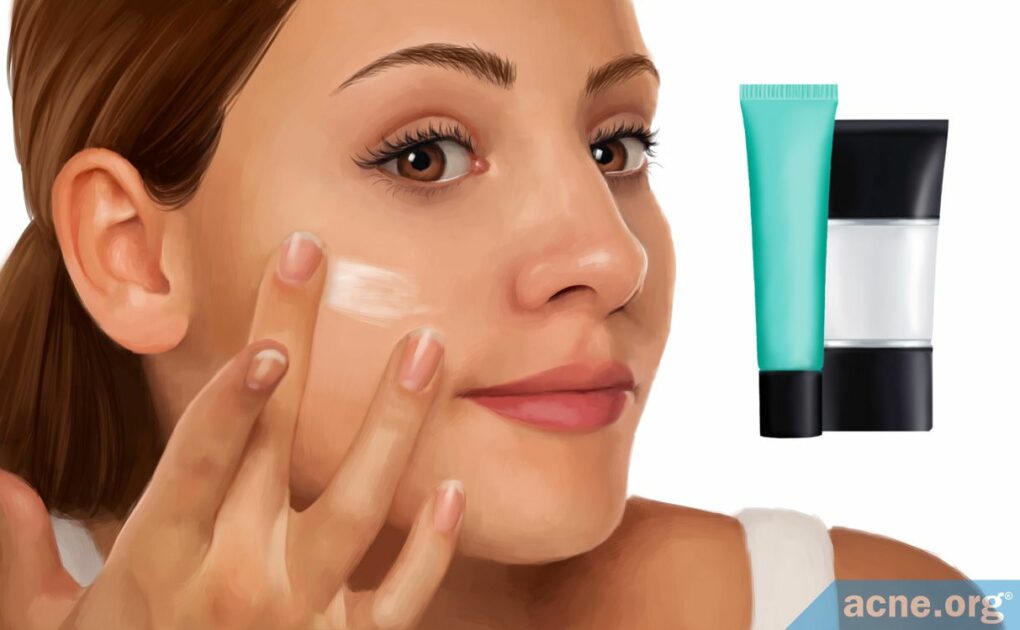Select a Primer That Does Not Contain Any Pore-clogging Ingredients and Apply It Gently

The Essential Info
When choosing a primer for acne-prone skin, take a look at the ingredients. Avoid primers with pore-clogging ingredients.
Also steer clear of fragranced primers, because fragrances may irritate the skin or may cause allergies in some people.
A primer containing sunscreen may be preferable if you are not using a foundation of the primer that offers sun protection. Some primers are labeled as “anti-acne,” which usually means they contain a small amount of salicylic acid, an anti-acne active ingredient. This is also a welcome addition.
Important Considerations When Using Primer
- Apply it gently: Be very gentle when you apply primer so as not to irritate the skin.
- Remove makeup before bed: Be sure to very gently remove primer and any makeup you put on top of it before bed.
- Don’t use expired makeup: Expired makeup can go rancid or grow bacteria. Use only fresh primer.

The Science
- Guidelines for Choosing a Primer for Acne-prone Skin
- List of Common Comedogenic Ingredients in Makeup
- Tips for Using Primer on Acne-prone Skin
Primer is a makeup product that many people use as a base before applying other makeup. In the same way that paint primers prepare surfaces for painting, makeup primers prepare the skin for the application of other makeup. Primers help makeup to adhere (stick) to the skin and allow makeup to stay on the skin longer. They do so by evening out the skin surface, smoothing out pores and fine lines.1,2
Primers can be moisturizing, mattifying, or tinted, and can come in liquid, semi-solid, or solid form. Regardless of the particular primer, the job of a primer is to:
- Improve the adherence (sticking) of makeup to the skin
- Prevent makeup from wearing off during the day
- Give the skin a luminous finish
- Even out the skin tone (in the case of tinted primer)1,2
Different kinds of primers prepare the skin for different kinds of makeup:
- Foundation primers: Prepare the skin for foundation
- Lip primers: Prepare the skin for lip makeup
- Eyelid primers: Prepare the eyelids for eye shadow
- Mascara primers: Prepare the eyelashes for mascara1
With the large variety of primer products on the market today, choosing the right primers for acne-prone skin is a formidable task. Selecting a foundation primer that is safe for acne-prone skin is particularly important, because unlike lip and eyelid primers, foundation primer is used on those parts of the face where acne can develop.
To select a primer that is safe for acne-prone skin, follow these simple guidelines:
Guidelines for Choosing a Primer for Acne-prone Skin
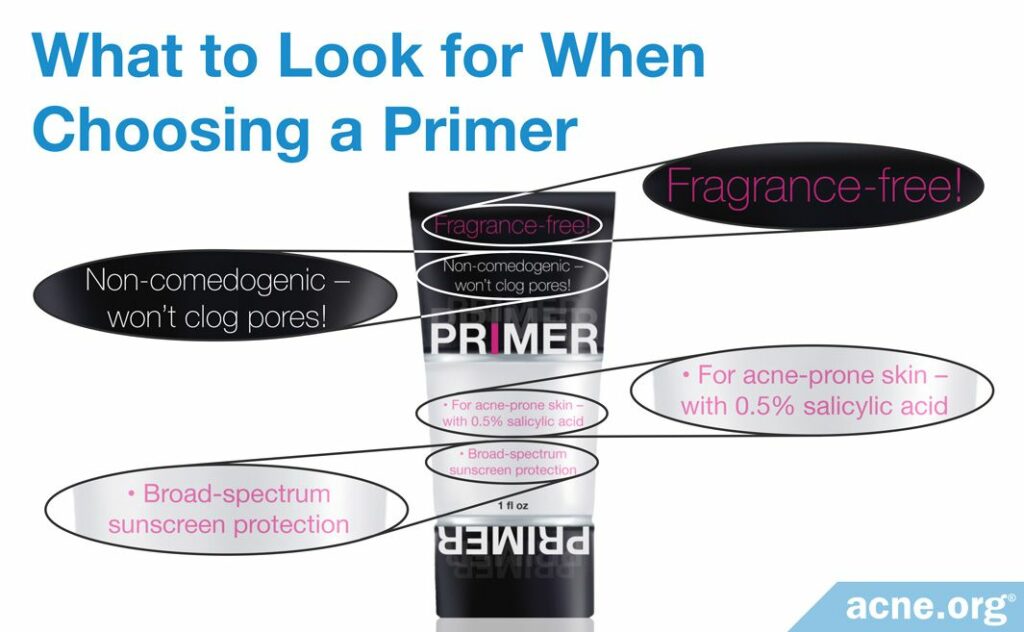
- Avoid pore-clogging ingredients: Look at the ingredient list of any primer before you buy it. Avoid primers that contain pore-clogging (comedogenic) ingredients. The table below gives a comprehensive list of common comedogenic ingredients.
- Avoid primers containing fragrances: Fragrances are the ingredient most likely to cause allergies or to irritate your skin, which can make acne worse. The safest approach is to select a fragrance-free primer.
- If possible, select a primer made specifically for acne: Some primers say on the label “for acne-prone skin.” This usually means they contain salicylic acid, which is an over-the-counter anti-acne ingredient that is somewhat effective in reducing breakouts. The concentration of salicylic acid in makeup is low, however–usually 0.5%–so it is unlikely to lead to much improvement in acne. Still, it can’t hurt to use a primer with a small amount of salicylic acid.
- Sunscreen in your primer is an added bonus: If you spend a lot of time outdoors and in the sun, protecting your skin from the sun’s rays is important. Foundation primer containing broad-spectrum sunscreen is a good choice, but if your primer does not have this ingredient, you can always purchase a separate sunscreen product or use a foundation that includes sunscreen.
List of Common Comedogenic Ingredients in Makeup
A large body of research has looked at how likely various ingredients are to cause clogged pores (comedones).3 We have combed through this research to compile two lists:
- Definitely avoid: These are ingredients that people with acne-prone skin should definitely avoid, because a compelling amount of data shows that they are comedogenic.
- Consider avoiding: These are ingredients that people with acne-prone skin may want to consider avoiding, because some data indicate that they might be comedogenic.
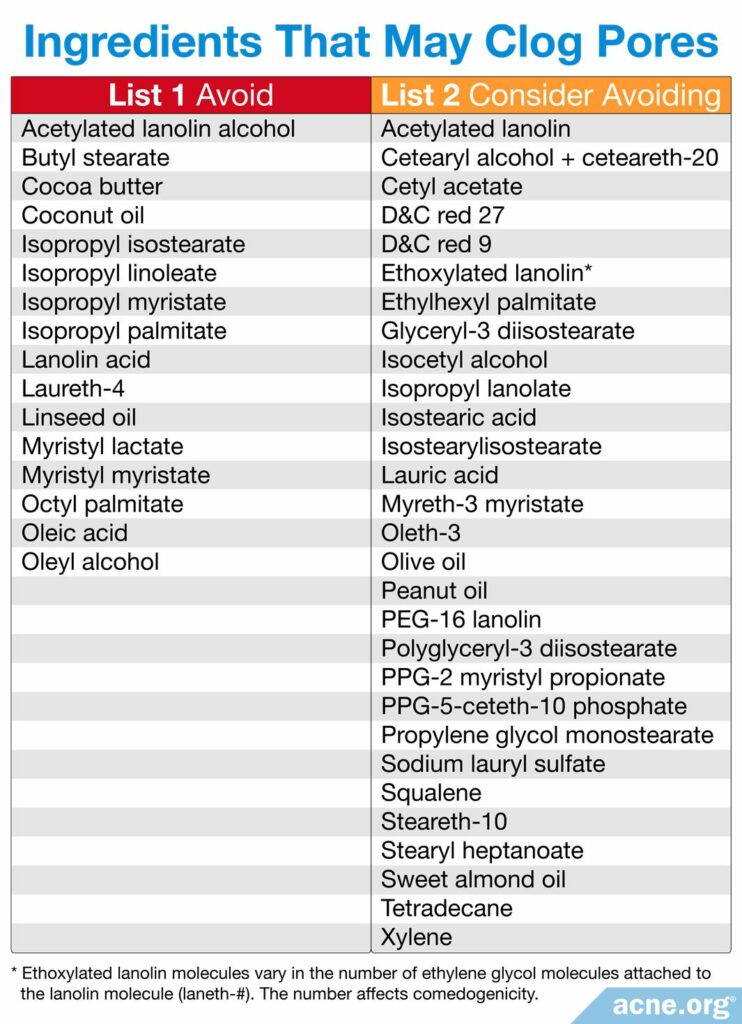
Tips for Using Primer on Acne-prone Skin
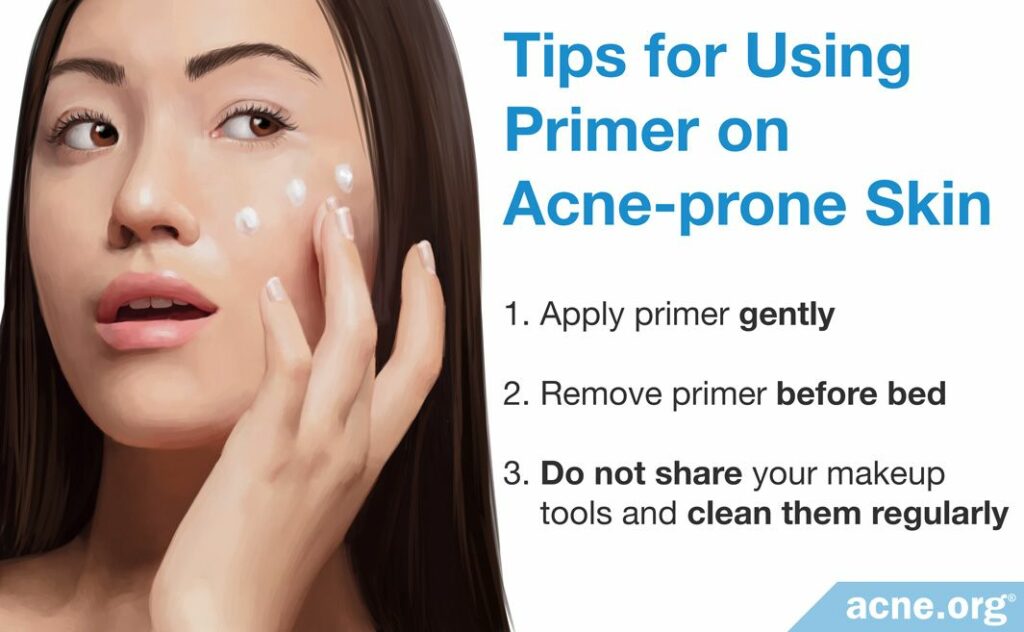
We know that physical irritation of the skin can make acne worse, so it is important to avoid irritating the skin whenever you apply primer or other makeup to acne-prone skin. In addition, poor hygiene can lead to skin infections, so keeping your makeup tools clean is also essential. When you use primer on acne-prone skin, keep these tips in mind:
- Apply primer gently: To avoid irritating the skin, use your bare hands if at all possible. If you are using a primer that you cannot apply with simply your bare hands, choose the softest makeup brushes or sponges, and be very gentle when applying primer.
- Remove primer before bed: It is good practice to remove any makeup, including primer, before going to bed, because the skin is more vulnerable at night. Be gentle when removing primer so as not to irritate the skin.
- Do not share your makeup tools and clean them regularly: Do not share your makeup brushes or sponges with anyone, because sharing makeup tools increases your chances of catching a skin infection. Choose disposable tools or clean your tools regularly to prevent the growth of bacteria and mold.
Primer Ingredients: The Full Scoop
Types of primers
A primer’s name reflects the type of makeup that the primer prepares the skin for:
- Foundation primers prepare the skin for the application of foundation
- Lip primers prepare the skin for the application of lip makeup
- Eyelid primers prepare the eyelids for the application of eye shadow
- Mascara primers prepare the eyelashes for the application of mascara1
When it comes to their texture, primers fall into three categories:
1. Solid primers
2. Semi-solid primers
3. Liquid primers1,2
Lastly, some primers contain ingredients that lend them special properties or create specific visual effects, for example:
- Moisturizing primers help the skin to retain moisture
- Mattifying primers even out the texture of the skin and create a matte skin surface
- Tinted primers even out the skin tone1
Primer ingredients
Primer ingredients vary depending on the product. The table below shows the most common types of ingredients in primers.2 Some of these ingredient types may be comedogenic or irritating and are therefore marked with an asterisk (*). Before buying a primer, consult the list of ingredients and ensure that none of them appear in the list of comedogenic ingredients at the beginning of this article.
In addition, avoid primers that contain ingredients to which you have an allergy. If you are uncertain whether you are allergic to a makeup product, one option is to perform a patch test. Place a small amount of product on an inconspicuous patch of skin and wait several hours to see whether you experience skin irritation or itching.
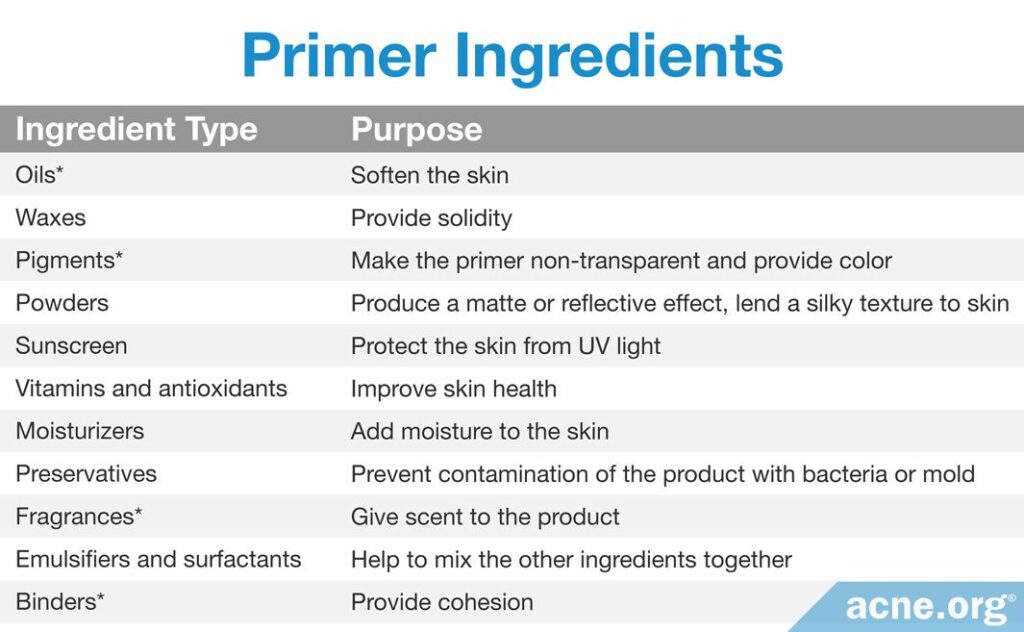
Sunscreen in primers
Protect your skin from the sun’s rays is important if you spend a large amount of time in the sun. Too much sun exposure can cause sunburn, and in people with acne, it can also worsen so-called post-inflammatory hyperpigmentation (darkening of acne lesions after they heal).

According to an article published in 2012 in the Journal of Clinical and Aesthetic Dermatology, “Cosmetics, such as foundation makeup, help provide…everyday protection [from the sun].”4
Therefore, if you plan to be outdoors and in the sun, opt for primer that contains broad-spectrum sunscreen if possible. Otherwise, you can use a separate sunscreen product, or choose a foundation that contains sunscreen.
Salicylic acid in primer
Some primers marketed for acne-prone skin contain salicylic acid, which is somewhat effective against acne. However, makeup is legally only allowed to contain a small amount of salicylic acid: 2% at the maximum, and most fall well below this amount, normally at 0.5%. At this low concentration, salicylic acid in your primer probably will not dramatically improve your acne. Still, if you can find a primer with this ingredient, it might be beneficial–but primer without this ingredient can be a good choice as well.
References
- Available from: https://en.wikipedia.org/wiki/Primer_(cosmetics). Accessed on 14/08/2017.
- Method And Compositions For Improving Wear Of Color Cosmetics, United States, Patent Application Publication, Pub. No.: US20140271511 A1, Pub. Date: Sep 18, 2014. https://patents.google.com/patent/US20140271511A1/en
- Katoulis A. C., Kakepis E. M., Kintziou H., Kakepis M. E. & Stavrianeas N. G., Comedogenicity of cosmetics: a review, Journal of the European Academy of Dermatology and Venereology, 7, 115-119 (1996). https://onlinelibrary.wiley.com/doi/abs/10.1111/j.1468-3083.1996.tb00606.x
- Dale Wilson, B., Moon, S., & Armstrong., F. (2012). Comprehensive Review of Ultraviolet Radiation and the Current Status on Sunscreens. The Journal of Clinical and Aesthetic Dermatology, 5, 18 – 23. https://www.ncbi.nlm.nih.gov/pmc/articles/PMC3460660/
 Acne.org Products
Acne.org Products